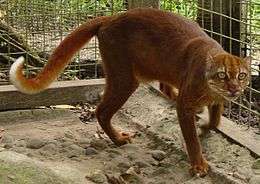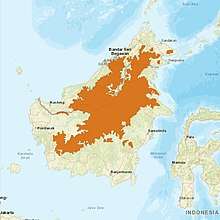Bay cat
The bay cat (Catopuma badia), also known as Borneo bay cat and Bornean bay cat, is a wild cat endemic to the island of Borneo that appears to be relatively rare compared to sympatric wild cats, based on the paucity of historical, as well as recent records. Since 2002, it has been listed as Endangered on the IUCN Red List because it is estimated that fewer than 2,500 mature individuals exist, and that the population declined in the past.[1] The bay cat has been recorded as rare and seems to occur at relatively low density, even in pristine habitat.[2]
| Bay cat | |
|---|---|
 | |
| Scientific classification | |
| Kingdom: | Animalia |
| Phylum: | Chordata |
| Class: | Mammalia |
| Order: | Carnivora |
| Suborder: | Feliformia |
| Family: | Felidae |
| Subfamily: | Felinae |
| Genus: | Catopuma |
| Species: | C. badia |
| Binomial name | |
| Catopuma badia | |
 | |
| Distribution of Bay Cat, 2016[1] | |
| Synonyms | |
|
Pardofelis badia | |
Taxonomy and evolution
Felis badia was the scientific name proposed by John Edward Gray in 1874, who first described a bay cat skin and skull collected by Alfred Russel Wallace in 1856 in Sarawak. This cat was first thought to be a kitten of an Asian golden cat.[3] In 1932, Reginald Innes Pocock placed the species in the monotypic genus Badiofelis.[4] In 1978, it was placed in the genus Catopuma.[5]
Tissue and blood samples were acquired only in late 1992 from the female brought to the Sarawak Museum.[6] Morphological and genetic analysis confirmed the close relationship with the Asian golden cat, and that the two species had been separated from a common ancestor for 4.9 to 5.3 million years, long before the geological separation of Borneo from mainland Asia.[7]
The bay cat's classification as Catopuma was widely recognized until 2006.[8] Because of the evident close relationship of the bay cat and the Asian golden cat with the marbled cat, all three species were suggested in 2006 to be grouped in the genus Pardofelis.[9]
Characteristics

The bay cat is much smaller than the Asian golden cat. Its fur is of a bright chestnut colour, rather paler beneath, the limbs and the tail being rather paler and redder. The tail is elongated, tapering at the end, with a white central streak occupying the rear half of the lower side, gradually becoming wider and of a purer white towards the tip, which has a small black spot at its upper end. The ears are rounded, covered with a short blackish-brown fur at the outer side, paler brown within and with a narrow brown margin.[3]
In the years between 1874 and 2004, only 12 specimens were measured. Their head-to-body length varied from 49.5–67 cm (19.5–26.4 in) with 30.0- to 40.3-cm-long tails.[10] They were estimated to have an adult weight of 3–4 kg (6.6–8.8 lb), but too few living specimens have been obtained to allow a more reliable estimate.[6]
The short, rounded head is dark greyish-brown with two dark stripes originating from the corner of each eye, and the back of the head has a dark ‘M’-shaped marking. The backs of the ears are dark greyish, lacking the central white spots found on many other cat species. The underside of the chin is white and two faint brown stripes are on the cheeks. Body proportions and the extremely long tail give it the look of the New World jaguarundi.[11]
Distribution and habitat
In the 19th century, only seven bay cat skins surfaced, but a living individual was caught only in 1992. It was trapped on the Sarawak – Indonesian border and brought to the Sarawak Museum on the verge of death.[6]
In the mid 1990s, the most reliable sightings have been reported in Gunung Palung National Park and the upper Kapuas River in West Kalimantan. Two concentrations were reported in the island's interior at the time, in habitat types varying from swamp forests, lowland dipterocarp forest to hill forests up to at least 500 m (1,600 ft).[12] One unconfirmed sighting occurred at 1,800 m (5,900 ft) on Mount Kinabalu.[13] It inhabits dense tropical forests, and has been observed in rocky limestone outcrops and in logged forest, and close to the coast. At least three specimens were found near rivers, but this was probably due to collector convenience rather than evidence of habitat preference. In 2002, a bay cat was photographed in Sarawak's Gunung Mulu National Park.[14] From 2003 to 2005, 15 bay cats were recorded in Kalimantan, Sabah, and Sarawak, but none in Brunei. These records consist of single opportunistic observations. Almost all the historical and recent records are from close proximity to water bodies such as rivers and mangroves, suggesting the bay cat may be closely associated with such habitats.[10]
A camera trapping survey from July 2008 to January 2009 in the northwestern part of Sabah's Deramakot Forest Reserve in an area of about 112 km2 (43 sq mi) yielded one photo of a male bay cat in a total sampling effort of 1916 trap nights. This record expands the range of bay cats to the north.[15]
In Central Kalimantan, a single bay cat was recorded in a mosaic of heath and peat swamp forest in the Rungan River catchment area during surveys carried out between 2016 and 2018.[16]
Ecology and behavior
The secretive and nocturnal behavior of the bay cat, and possibly the low population density, may be an important cause of the rarity of sightings.[12] Camera trapping surveys during 2003–2006 yielded only one photo of a bay cat in 5,034 trap nights. According to unconfirmed anecdotal records from Sarawak, a bay cat was observed on a branch 1 m (3.3 ft) from the ground close to the river during a night hunting expedition. A local animal collector near Lachau, Sarawak, claimed he accidentally trapped two bay cats on separate occasions in December 2003. He reported the bay cats entered his aviary and attacked his pheasants. One cat died in captivity, and the other was released.[10]
Nothing is known about its feeding ecology and reproductive behavior.[11][15][17]
Threats

The bay cat is forest-dependent and increasingly threatened by habitat destruction following deforestation in Borneo. Habitat loss due to commercial logging and conversion to oil palm plantations pose the greatest threat to the bay cat. Oil palm plantations are likely to expand in the future as a result of the push for biofuels.[1] Borneo has one of the world's highest deforestation rates. While in the mid-1980s, forests still covered nearly three-quarters of the island, by 2005 only 52% of Borneo was still forested. Both forests and land make way for human settlement.[18]
Illegal trade in wildlife also poses a significant threat. Wildlife traders are aware of the species' rarity, and bay cats have been captured illegally from the wild for the skin and pet markets.[1]
Although Borneo supposedly has 25 wildlife reserves, only three are actually in existence, with the others only proposed. All of these reserves have been encroached upon by human settlement and logging.
Conservation
The bay cat is listed on CITES Appendix II. It is fully protected by national legislation across most of its range. Hunting and trade are prohibited in Kalimantan, Sabah, and Sarawak. The bay cat remains one of the least studied of the world's wild cats, hampering the development of conservation actions.[1]
References
- Hearn, A.; Brodie, J.; Cheyne, S.; Loken, B.; Ross, J. & Wilting, A. (2016). "Catopuma badia". IUCN Red List of Threatened Species. 2016: e.T4037A112910221.
- Povey, K.; Sunarto, H. J. G.; Priatna, D.; Ngoprasert, D.; Reed, D.; Wilting, A.; Lynam, A.; Haidai, I.; Long, B.; Johnson, A.; Cheyne, S.; Breitenmoser, C.; Holzer, K. & Byers, O. (2009). Clouded Leopard and Small Felid Conservation Summit Final Report (PDF) (Report). Apple Valley, MN: IUCN/SSC Conservation Breeding Specialist Group.
- Gray, J. E. (1874). "Description of a new Species of Cat (Felis badia) from Sarawak". Proceedings of the Scientific Meetings of the Zoological Society of London for the Year 1874: 322–323.
- Pocock, R. I. (1932). "The marbled cat (Pardofelis marmorata) and some other Oriental species, with a definition of a new genus of the Felidae". Proceedings of the Zoological Society of London (102): 741–766.
- Hemmer, H. (1978). "The evolutionary systematics of living Felidae: Present status and current problems". Carnivore. 1 (1): 71–79.
- Sunquist, M. E.; Leh, C.; Hills, D. M.; Rajaratnam, R. (1994). "Rediscovery of the Bornean Bay Cat". Oryx. 28: 67–70. doi:10.1017/S0030605300028313.
- Johnson, W. E.; Ashiki, F. S.; Menotti Raymond, M.; Driscoll, C.; Leh, C.; Sunquist, M.; Johnston, L.; Bush, M.; Wildt, D.; Yuhki, N.; O'Brien, S. J. & Wasse, S. P. (1999). "Molecular genetic characterization of two insular Asian cat species, Bornean Bay cat and Iriomote cat". In Vasser, S. P. (ed.). Evolutionary Theory and Process: Modern perspectives. Papers in Honour of Eviatar Nevo. Dordrecht: Kluwer Academic Publishing. pp. 223–248. ISBN 9780792355182.
- Wozencraft, W.C. (2005). "Species Catopuma badia". In Wilson, D.E.; Reeder, D.M (eds.). Mammal Species of the World: A Taxonomic and Geographic Reference (3rd ed.). Johns Hopkins University Press. pp. 545–546. ISBN 978-0-8018-8221-0. OCLC 62265494.
- Johnson, W. E.; Eizirik, E.; Pecon-Slattery, J.; Murphy, W. J.; Antunes, A.; Teeling, E. & O'Brien, S. J. (2006). "The late miocene radiation of modern Felidae: a genetic assessment". Science. 311 (5757): 73–77. Bibcode:2006Sci...311...73J. doi:10.1126/science.1122277. PMID 16400146.
- Mohd-Azlan, J.; Sanderson, J. (2007). "Geographic distribution and conservation status of the bay cat Catopuma badia, a Bornean endemic". Oryx. 41 (3): 394–397. doi:10.1017/S0030605307000516.
- Sunquist, M.; Sunquist, F. (2002). "Bay cat Catopuma badia (Gray, 1874)". Wild cats of the World. Chicago: University of Chicago Press. pp. 48–51. ISBN 0-226-77999-8.
- Meijaard, E. (1997). "The bay cat in Borneo". Cat News (27): 21–23.
- Payne, J. C. M.; Francis, C. M.; Phillipps, K. (1985). A field guide to the mammals of Borneo. Kota Kinabalu, Malaysia: The Sabah Society.
- Dinets, V. (2003). "First photo of Bornean bay cat in the wild?". Cat News (38): 14.
- Mohamed, A.; Samejima, H.; Wilting, A. (2009). "Records of five Bornean cat species from Deramakot Forest Reserve in Sabah, Malaysia". Cat News (51): 12–15.
- Jeffers, K. A.; Adul; Cheyne, S. M. (2019). "Small cat surveys: 10 years of data from Central Kalimantan, Indonesian Borneo". Journal of Threatened Taxa. 11 (4): 13478–13491. doi:10.11609/jott.4466.11.4.13478-13491.
- Nowell, K.; Jackson, P. (1996). "Bornean Bay Cat". Wild Cats: status survey and conservation action plan. Gland, Switzerland: IUCN/SSC Cat Specialist Group.
- Rautner, M., Hardiono, M., Alfred, R. J. (2005). Borneo: treasure island at risk. Status of Forest, Wildlife, and related Threats on the Island of Borneo. WWF Germany.
External links
| Wikimedia Commons has media related to Pardofelis badia. |
| Wikispecies has information related to Pardofelis badia |
